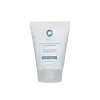What's inside
What's inside
 Key Ingredients
Key Ingredients

 Benefits
Benefits

 Concerns
Concerns

 Ingredients Side-by-side
Ingredients Side-by-side

Ethylhexyl Palmitate
EmollientHelianthus Annuus Seed Oil
EmollientPolyglyceryl-10 Diisostearate
EmulsifyingPolyglyceryl-6 Dicaprate
EmulsifyingPolyethylene
AbrasiveCetearyl Alcohol
EmollientDipropylene Glycol
HumectantCI 77891
Cosmetic ColorantCaprylic/Capric Triglyceride
MaskingVigna Radiata Seed Extract
Skin ConditioningCamellia Sinensis Seed Oil
HumectantMelia Azadirachta Leaf Extract
Skin ConditioningAluminum Hydroxide
EmollientCapryloyl Salicylic Acid
ExfoliatingHippophae Rhamnoides Fruit Oil
Skin ProtectingMelia Azadirachta Flower Extract
Skin ConditioningCoccinia Indica Fruit Extract
Skin ConditioningWater
Skin ConditioningSolanum Melongena Fruit Extract
Skin ConditioningAmber Powder
Ceramide NP
Skin ConditioningGluconolactone
Skin ConditioningCurcuma Longa Root Extract
MaskingOcimum Sanctum Leaf Extract
Skin ConditioningGlycerin
HumectantCorallina Officinalis Extract
Skin ConditioningMoringa Oleifera Seed Oil
EmollientButylene Glycol
Humectant1,2-Hexanediol
Skin ConditioningLactobacillus/Soymilk Ferment Filtrate
Skin ConditioningHydrogenated Lecithin
EmulsifyingAsiaticoside
AntioxidantMadecassic Acid
Skin ConditioningAsiatic Acid
Skin ConditioningCholesterol
EmollientEthylhexyl Palmitate, Helianthus Annuus Seed Oil, Polyglyceryl-10 Diisostearate, Polyglyceryl-6 Dicaprate, Polyethylene, Cetearyl Alcohol, Dipropylene Glycol, CI 77891, Caprylic/Capric Triglyceride, Vigna Radiata Seed Extract, Camellia Sinensis Seed Oil, Melia Azadirachta Leaf Extract, Aluminum Hydroxide, Capryloyl Salicylic Acid, Hippophae Rhamnoides Fruit Oil, Melia Azadirachta Flower Extract, Coccinia Indica Fruit Extract, Water, Solanum Melongena Fruit Extract, Amber Powder, Ceramide NP, Gluconolactone, Curcuma Longa Root Extract, Ocimum Sanctum Leaf Extract, Glycerin, Corallina Officinalis Extract, Moringa Oleifera Seed Oil, Butylene Glycol, 1,2-Hexanediol, Lactobacillus/Soymilk Ferment Filtrate, Hydrogenated Lecithin, Asiaticoside, Madecassic Acid, Asiatic Acid, Cholesterol
Ethylhexyl Palmitate
EmollientHydrogenated Styrene/Isoprene Copolymer
Neopentyl Glycol Dicaprate
EmollientTriethylhexanoin
MaskingDextrin Palmitate
EmulsifyingEthylhexyl Palmitate, Hydrogenated Styrene/Isoprene Copolymer, Neopentyl Glycol Dicaprate, Triethylhexanoin, Dextrin Palmitate, Polyethylene, Laureth-4, PEG-8 Glyceryl Isostearate, Helianthus Annuus Seed Oil, Squalane, Phenoxyethanol, Tocopherol, Centella Asiatica Extract, Sodium Acetylated Hyaluronate
 Reviews
Reviews

Ingredients Explained
These ingredients are found in both products.
Ingredients higher up in an ingredient list are typically present in a larger amount.
Ethylhexyl Palmitate, also known as octyl palmitate, is created from 2-ethylhexyl alcohol and palmitic acid. It is a fatty acid ester.
The fatty acid content of Ethylhexyl Palmitate makes it an emollient. Emollients help soften and hydrate your skin by trapping moisture within.
Ethylhexyl Palmitate is also used to help improve the texture of cosmetics. It helps other ingredient dissolve in products and help disperse ingredients more evenly.
You'll likely find this ingredient in sunscreen, as it is often used to mix UV-blocking ingredients such as avobenzone and ethylhexyl triazone.
It can also help stabilize the fragrances in a product as a fragrance fixative.
Ethylhexyl Palmitate can be used to substitute mineral oil.
Due to its high fatty acid content, it may not be fungal-acne safe.
Learn more about Ethylhexyl PalmitateHelianthus Annuus Seed Oil is the oil derived from the seeds of a Sunflower. Sunflower seed oil is non-fragrant. It is an emollient, meaning it helps to soften the skin.
Sunflower seed oil contains many fatty acids. The fatty acids found in sunflower seeds include (from highest amount to least): linoleic acid, myristic acid, palmitic acid, stearic acid, arachidic acid, oleic acid, and linolenic acid.
These fatty acids help the skin create ceramides. Ceramides play a role in repairing the skin barrier.
Helianthus Annuus Seed Oil helps moisturize the skin. This in turn helps the skin look more rejuvenated and smoother.
Sunflowers are rich in vitamin E.
Historians believe Indigenous cultures of North America domesticated sunflowers before corn. Thus they relied on sunflower oil for a variety of uses. One such use is moisturizing skin and hair.
Sunflower seed oil may not be fungal acne safe. We recommend speaking with a professional if you have any concerns.
Learn more about Helianthus Annuus Seed OilPolyethylene is a synthetic ingredient that helps the skin retain moisture. It is a polymer.
It is also typically used within product formulations to help bind solid ingredients together and thicken oil-based ingredients. When added to balms and emulsions, it helps increase the melting point temperature.